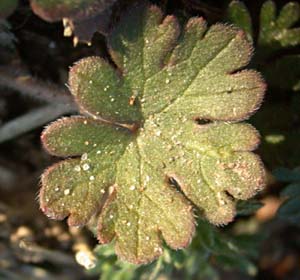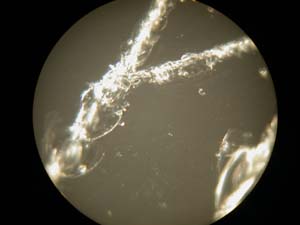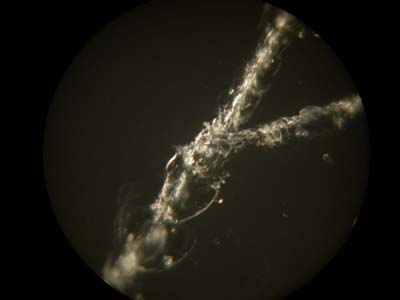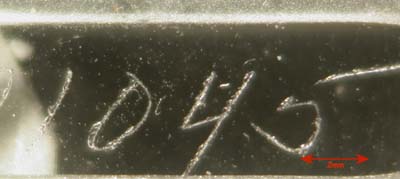
Henbit |
using a Short Tube Microscope Gordon Couger, USA |

Henbit |
using a Short Tube Microscope Gordon Couger, USA |
My thanks to David Jackson for the loan of the 2.5x objective and Charley Meyer for the advice, patience and use of the Leitz 1x plan and 12.5 mm Leitz Photar objective. Both added a great deal to this effort.When I started looking at a solution for in the field macro photography I ran in to a hard wall at about 4x or 5x. Conventional close-up filters don't work very well with the Nikon CoolPix. They do give more working distance but they don't give much magnification.
The images of henbit and the bud with spider webs were taken handheld on autofocus using 400ASA speed. Clicking on each image will bring up a higher resolution version of it.
In talking to Mark Simmons he told me that he had a short tube microscope to go with the eyepiece adapter which worked well with a 4x objective that gave approximately 20x magnification. I built an experimental one and found that the 3x objective I had, had a much lower magnification and it appeared that it would work with at least a 10x as well, so I ordered one. The results of the magnification are at the bottom of the page. I used Mark's 80 mm tube and eyepiece with a 2.5x, 4x, 10x and 25x objective in the test using a Nikon 995 using autofocus, spot metering, image sharpening set on low. No enhancement has been done to the photos. They can be brought up at half resolution by double clicking on each image.
Using the 2.5x objective outdoors in good light, hand held, yielded about 50% in focus pictures if I rest the camera against something while using autofocus. A good tripod will help this a good deal. A flash is considerable help.While I haven't used this flash in the field yet, I have built a flash from the parts taken from a one time use camera using a ping pong ball as a diffusing sphere by cutting a hole in the ping pong ball and giving multiple coats of white paint and glass microspheres. I use a triac and solar cell to trigger the flash. It synchronizes with the camera at 1/2000th and provides illumination that is not nearly as harsh as a normal flash. It is a very good match for the 2.5x and 4x objectives. See the footnotes for information on the slave and other electronic flash information.
I am still having trouble with the microscope I am building and trying to use the flash in the reflected light nose piece. I expect that I have too much light inside the tube and I am getting flare off the back of the objective. I doubt that I will ever be able to use high light levels in a reflected light scope. But mounting a flash in a Plexiglas ring around the objective will work.Shortening the tube reduces the magnification and increases the working distance of the objective. The tube length of the objective becomes less critical as the aperture decreases. A 100x NA1.4 objective has no tolerance on tube length while a 2.5x./.10 has a great deal of leeway. The 80 mm tube works with objectives from 2.5x/.10 to 25x/.50. It was too short for a 1x Leitz plan to focus. I expect that a 2x would focus on the tube. The working distance rapidly increases as the power of the objective decreases as there is a noticeable difference in a 2.8x and 2.5x objective.
Also lenses like the Leitz Photar and reversed cine (movie camera) lenses that work with a microscope eyepiece also work as a close-up lens as well. A 1 inch cine lens connected directly to an eyepiece appears to work quite well. Thank to Charlie's suggestions.
These are the fields of the objective from 2.5x to 25x using an 80 mm tube made by Mark Simmons and the eyepiece adapter he makes for a Nikon CoolPix. The pictures were taken with a CoolPix 995 on a copy stand using autofocus and spot metering. One exposure each was taken at maximum zoom for each extreme. Using achromat microscope objectives, a flat field of focus could not be obtained at the widest zoom. When zoomed in enough to fill the frame with an image it does not seem to be much of a problem in practice. Using a Leitz 1x plan and 12.5 mm Leitz Photar that belongs to Charley Meyer I was able to get a flat field. The 1x Leitz would not focus on the 80 mm tube but took one about 100 mm long. The better lenses had better contrast and flatter fields but it won't keep you from making good images with achromats of real world items. Autofocus only works over a very narrow range and does not always get the image you want. I find that several images using autofocus and the ten second timer work better for me than trying to use manual focus and the LCD screen outdoors to focus. The depth of focus is very shallow and you never know when the camera will snap the picture. Trying to use manual focus under those conditions has not been productive for me.
With the availability of programs such as CombineZ and others that allow stacking of many images taken at different focus planes and combining them into one image, the need for flat field optics is not as critical as it once was.
All comments to the author Gordon Couger are welcomed.
Graduations are in millimeters.

2.5x wide
2.5x zoom
4x wide
4x zoom

10x wide |

10x zoom |

25x wide |

25x zoom |

Source of 25x image |
Referenced products
Mark Simmons' Perspective Image
Combine Z
Electronic Flash information
http://www.chem.helsinki.fi/~toomas/photo/flash-faq.html
http://www.repairfaq.org/REPAIR/F_strbfaq.html
http://www.couger.com/microscope/projects/coolpixsave.html
Please report any Web problems or offer general comments to the Micscape Editor.
Micscape is the on-line monthly magazine
of the Microscopy UK web
site at Microscopy-UK
WIDTH=1